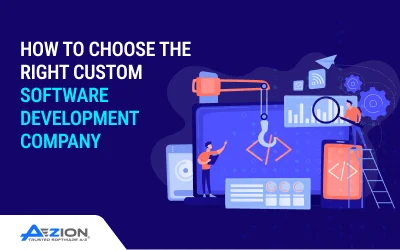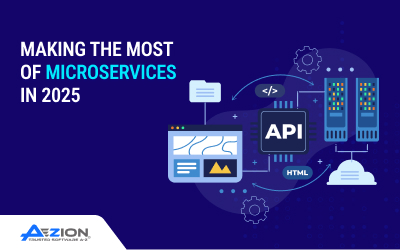How To Create a Blockchain Application for Your Business
The blockchain is known for being a distributed, decentralized architecture. Thanks to its inherent security features, businesses are tapping into its capabilities for their applications. If you’re thinking about creating blockchain applications, read on.
This guide will explain how these applications work and how to develop your own, whether you opt for a BaaS solution or decide to start from scratch.
Why Are Blockchain Applications Useful?
Blockchain applications, also known as decentralized apps or “DApps,” are any applications built upon blockchain architecture. What makes blockchain architecture special is that it is both decentralized and distributed. This means that there is no centralized server acting as the intermediary between users.
The blockchain gives every user on the network their copy of the ledger, so the network grows more secure as more users join. With more users verifying the transactions of other users, there is inherent protection against fraud and errors.
Blockchain is often called a “trustless” environment because it distributes equal power and control among all participants, creating a highly secure environment with high traceability and transparency. Given its advantages for security and data governance, many businesses are exploring creation of blockchain applications, particularly for internal use.
There are numerous benefits to developing blockchain applications. The big question is: Where should you begin with your DApp development plan?
How To Create a Blockchain Application
Developing a blockchain application does not have to be an overly technical or time-consuming endeavor. In fact, if you start with these guidelines then consult a blockchain expert, your business will be well on its way to a successful blockchain application.
1. Understand Your Requirements
You’d be mistaken if you dismissed blockchain apps for your business due to a belief that blockchain benefits are offset by the challenges associated with an inflexible and overly complex blockchain architecture. Many businesses initially dismiss the idea of a blockchain application because they feel that the traceability and transparency aspects can compromise their security. In practice, most businesses end up adopting a “permission” blockchain. This approach leverages the same concepts as a permissionless blockchain (where all users are equal), except a permissioned blockchain helps organizations implement user access controls for security and privacy purposes.
With a permissioned blockchain, users can only access your network once granted authorization to do so. Even then, you must assign a role and specific permissions to each user. This means that only authorized members of your organization can access the underlying code, interact with other users, and verify transactions.
Deciding between a permissionless and permissioned blockchain app is the first step in designing your business’s ideal solution. Of course, it goes beyond that. As you work to fully understand the requirements for your new application, you should start thinking about the functional scope, number of users you intend to support, and your performance requirements — as performance is a critical consideration with blockchain applications.
2. Choose Your Approach
As you work to lay out your requirements for your app in a practical sense, the next step is to think about the underlying architecture that will make it all happen. Many businesses are deterred from developing a blockchain app because they simply don’t feel that they have the technical expertise or other resources to devote to its creation.
The fact is, you can aspire to creation of a custom blockchain application for your business even if you don’t have an IT or development team on staff. With the rise in popularity of DApps in recent years, there are multiple options for custom development. These include:
- Leverage blockchain-as-a-service providers, also known as “BaaS” platforms, which allow you to build upon their cloud-based blockchain services. Major cloud providers like Amazon and Microsoft offer BaaS solutions.
- Utilize blockchain frameworks to create a private network on your own. Depending on the options you choose, this could simplify the underlying development and management of the blockchain architecture.
- Build on an open blockchain, like Ethereum or Bitcoin for your unique use case. It is generally advisable to build a DApp on a public blockchain when the DApp requires decentralized access, high scalability, higher security, faster transactions and low transaction costs.
It’s important to note that there is no single “right” way to develop a blockchain application for your business, but most will choose to start with blockchain-as-a-service providers. However, while partnering with a blockchain-as-a-service provider handles the underlying architecture so that you can get to a working product sooner, it’s critical to recognize that there is still inherent cost, resource consumption, and risk associated with any DApp development project.
3. Design Your Launch Plan
Ultimately, the detailed development process and timeline will vary greatly depending on several factors. In any case, it’s important that you identify your approach and then sit down with key stakeholders to lay out a complete game plan. Researching and planning as much as you can in advance will help you minimize risk and save time.
As you plan your development project, you must:
- Gather key stakeholders to discuss the purpose, direction, budget, and timeline of the project.
- Define the key business objectives you wish to accomplish due to the development project.
- Layout the core capabilities you need, along with additional features you may consider adding if time allows.
- Set milestones for development, performance testing, feedback, and user testing.
- Create a rollout and adoption plan, and start thinking about how you will get various departments on board.
- Do your best to account for all associated activities, especially cost and time associated with employee training.
By the time you’ve finished these steps, you’ll have crafted a good preliminary plan for your blockchain application. How soon you can get to the next step depends on the resources you have available and whether or not you’ve chosen to partner with an experienced blockchain development team.
Get Help With Your Next Development Project
Blockchain applications have proven to be productive, secure, and worthwhile when applied to the right problem. The question is, how do you minimize risk and achieve the best possible outcome without wasting resources? For most businesses, DApp development requires help from experts.
If you need assistance defining a plan and requirements for your DApp, it’s time to get a dedicated team on your side that can guide you around the common hurdles and pitfalls that can derail a project even before it starts. The professionals at Aezion can help make sure your project is a success.
Reach out to our team today to learn more.



